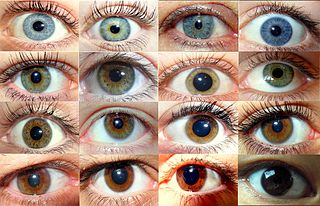
In the psychology of color, color preferences are the tendency for an individual or a group to prefer some colors over others, such as having a favorite color or a traditional color.

In the psychology of color, color preferences are the tendency for an individual or a group to prefer some colors over others, such as having a favorite color or a traditional color.
An 'ecological valence theory' (EVT) has been suggested to explain why people have preferences for different colors. This is the idea that the preference for color is determined by the average affective response to everything the individual associates with the color. Hence, positive emotional experiences with a particular color are likely to increase the propensity to develop a preference for that color and vice versa. Social and cultural factors also factor into this affective response. A study in 2011 on the effects of "school spirit" and color preferences found members of Berkeley were more likely to favor the school's official colors than rival university Stanford. This degree of preference was also correlated with their self-reported level of "school spirit". The researchers conducting the study concluded that this was evidence for the EVT. [1]
Infants as young as 12 weeks old exhibit color preferences. [2] Generally, children prefer the colors red/pink and blue, and cool colors are preferred over warm colors. Color perception of children 3–5 years of age is an indicator of their developmental stage. Color preferences tend to change as people age. [3]
Favoritism of colors varies widely. Often societal influences will have a direct impact on what colors are favored and disdained. In the West, the color black symbolizes mourning and sadness, red symbolizes anger and violence, white symbolizes purity and peace, and yellow symbolizes joy and luck (other colors lack a consistent meaning). From a recent study, it was discussed that associative learning is the process where an individual develops color preferences. In different countries, color preference vary. In China, red indicates luck, while in Nigeria and Germany it means the exact opposite. [4]

Color blindness or color vision deficiency (CVD) is the decreased ability to see color or differences in color. Some people with color blindness have major impairment: difficulty in reading traffic lights and some academic activities, discomfort in bright environments, decreased visual acuity, etc. However, most issues are minor, and people with colorblindness automatically develop adaptations and coping mechanisms.

The Kruithof curve describes a region of illuminance levels and color temperatures that are often viewed as comfortable or pleasing to an observer. The curve was constructed from psychophysical data collected by Dutch physicist Arie Andries Kruithof, though the original experimental data is not present on the curve itself. Lighting conditions within the bounded region were empirically assessed as being pleasing or natural, whereas conditions outside the region were considered uncomfortable, displeasing or unnatural. The Kruithof curve is a sufficient model for describing pleasing sources that are considered natural or closely resemble Planckian black bodies, but its value in describing human preference has been consistently questioned by further studies on interior lighting.

Color constancy is an example of subjective constancy and a feature of the human color perception system which ensures that the perceived color of objects remains relatively constant under varying illumination conditions. A green apple for instance looks green to us at midday, when the main illumination is white sunlight, and also at sunset, when the main illumination is red. This helps us identify objects.
Dichromacy is the state of having two types of functioning photoreceptors, called cone cells, in the eyes. Organisms with dichromacy are called dichromats. Dichromats require only two primary colors to be able to represent their visible gamut. By comparison, trichromats need three primary colors, and tetrachromats need four. Likewise, every color in a dichromat's gamut can be evoked with monochromatic light. By comparison, every color in a trichromat's gamut can be evoked with a combination of monochromatic light and white light.
Habituation is a form of non-associative learning in which an innate (non-reinforced) response to a stimulus decreases after repeated or prolonged presentations of that stimulus. Responses that habituate include those that involve the intact organism or those that involve only components of the organism. The broad ubiquity of habituation across all biologic phyla has resulted in it being called "the simplest, most universal form of learning...as fundamental a characteristic of life as DNA." Functionally-speaking, by diminishing the response to an inconsequential stimulus, habituation is thought to free-up cognitive resources to other stimuli that are associated with biologically important events. For example, organisms may habituate to repeated sudden loud noises when they learn these have no consequences. A progressive decline of a behavior in a habituation procedure may also reflect nonspecific effects such as fatigue, which must be ruled out when the interest is in habituation. Habituation is clinically relevant, as a number of neuropsychiatric conditions, including autism, schizophrenia, migraine, and Tourette's, show reductions in habituation to a variety of stimulus-types both simple (tone) and complex (faces).

Heterochromia is a variation in coloration most often used to describe color differences of the iris, but can also be applied to color variation of hair or skin. Heterochromia is determined by the production, delivery, and concentration of melanin. It may be inherited, or caused by genetic mosaicism, chimerism, disease, or injury. It occurs in humans and certain breeds of domesticated animals.

Eye color is a polygenic phenotypic trait determined by two factors: the pigmentation of the eye's iris and the frequency-dependence of the scattering of light by the turbid medium in the stroma of the iris.
The opponent process is a color theory that states that the human visual system interprets information about color by processing signals from photoreceptor cells in an antagonistic manner. The opponent-process theory suggests that there are three opponent channels, each comprising an opposing color pair: red versus green, blue versus yellow, and black versus white (luminance). The theory was first proposed in 1892 by the German physiologist Ewald Hering.
Microsaccades are a kind of fixational eye movement. They are small, jerk-like, involuntary eye movements, similar to miniature versions of voluntary saccades. They typically occur during prolonged visual fixation, not only in humans, but also in animals with foveal vision. Microsaccade amplitudes vary from 2 to 120 arcminutes. The first empirical evidence for their existence was provided by Robert Darwin, the father of Charles Darwin.

Infant vision concerns the development of visual ability in human infants from birth through the first years of life. The aspects of human vision which develop following birth include visual acuity, tracking, color perception, depth perception, and object recognition.

Fixation or visual fixation is the maintaining of the gaze on a single location. An animal can exhibit visual fixation if it possess a fovea in the anatomy of their eye. The fovea is typically located at the center of the retina and is the point of clearest vision. The species in which fixational eye movement has been verified thus far include humans, primates, cats, rabbits, turtles, salamanders, and owls. Regular eye movement alternates between saccades and visual fixations, the notable exception being in smooth pursuit, controlled by a different neural substrate that appears to have developed for hunting prey. The term "fixation" can either be used to refer to the point in time and space of focus or the act of fixating. Fixation, in the act of fixating, is the point between any two saccades, during which the eyes are relatively stationary and virtually all visual input occurs. In the absence of retinal jitter, a laboratory condition known as retinal stabilization, perceptions tend to rapidly fade away. To maintain visibility, the nervous system carries out a procedure called fixational eye movement, which continuously stimulates neurons in the early visual areas of the brain responding to transient stimuli. There are three categories of fixational eye movement: microsaccades, ocular drifts, and ocular microtremor. At small amplitudes the boundaries between categories become unclear, particularly between drift and tremor.
Advertising research is a systematic process of marketing research conducted to improve the efficiency of advertising. Advertising research is a detailed study conducted to know how customers respond to a particular ad or advertising campaign.
Color symbolism in art, literature, and anthropology refers to the use of color as a symbol in various cultures and in storytelling. There is great diversity in the use of colors and their associations between cultures and even within the same culture in different time periods. The same color may have very different associations within the same culture at any time. Diversity in color symbolism occurs because color meanings and symbolism occur on an individual, cultural and universal basis. Color symbolism is also context-dependent and influenced by changes over time. Symbolic representations of religious concepts or articles may include a specific color with which the concept or object is associated.

Color psychology is the study of hues as a determinant of human behavior. Color influences perceptions that are not obvious, such as the taste of food. Colors have qualities that can cause certain emotions in people. How color influences individuals may differ depending on age, gender, and culture. Although color associations can vary contextually between cultures, color preference is thought to be relatively uniform across gender and race.

Unique hue is a term used in perceptual psychology of color vision and generally applied to the purest hues of blue, green, yellow and red. The proponents of the opponent process theory believe that these hues cannot be described as a mixture of other hues, and are therefore pure, whereas all other hues are composite. The neural correlate of the unique hues are approximated by the extremes of the opponent channels in opponent process theory. In this context, unique hues are sometimes described as "psychological primaries" as they can be considered analogous to the primary colors of trichromatic color theory.
A repetitive visual stimulus is a visual stimulus that has a distinctive property. The stimuli are simultaneously presented to the user when focusing attention on the corresponding stimulus. For example, when the user focuses attention on a repetitive visual stimulus, a steady state visually evoked potential is elicited which manifests as oscillatory components in the user's electroencephalogram, especially in the signals from the primary visual cortex, matching the frequency or harmonics of that stimulus.

Davida Young Teller was a professor in the Departments of Psychology and Physiology/Biophysics at the University of Washington, Seattle, Washington. She was a leader in the scientific study of infant visual development.
The psychology of eating meat is a complex area of study illustrating the confluence of morality, emotions, cognition, and personality characteristics. Research into the psychological and cultural factors of meat-eating suggests correlations with masculinity, support for hierarchical values, and reduced openness to experience. Because meat eating is widely practiced but is sometimes associated with ambivalence, it has been used as a case study in moral psychology to illustrate theories of cognitive dissonance and moral disengagement. Research into the consumer psychology of meat is relevant both to meat industry marketing and to advocates of reduced meat consumption.

The colors pink and blue are associated with girls and boys respectively, in the United States, the United Kingdom and some other European countries.
Irissometry describes the method of detection, identification, and tracking of features in the iris and its deformations as a function of changes in pupil size and eye rotation.